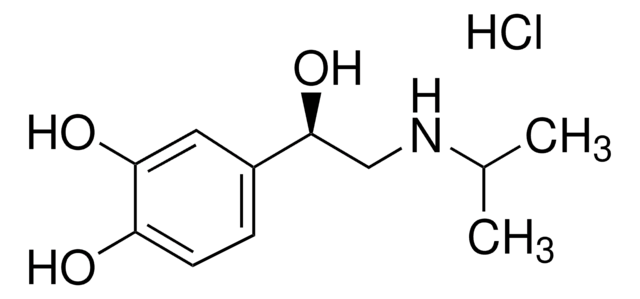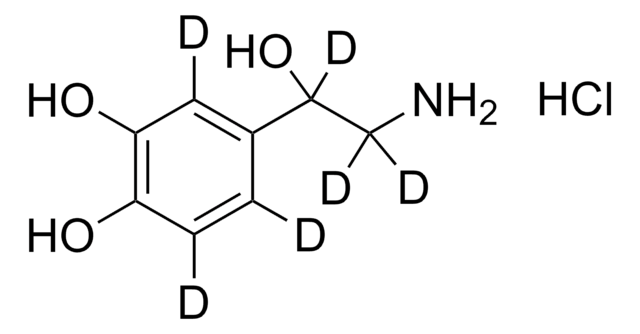I5627
Isoprenaline hydrochloride
≥98.5% (TLC), powder, β-adrenoceptor agonist
Synonim(y):
(±)-Isoproterenol hydrochloride, 1-(3′,4′-Dihydroxyphenyl)-2-isopropylaminoethanol hydrochloride, N-Isopropyl-DL-noradrenaline hydrochloride
About This Item
Polecane produkty
product name
Isoprenaline hydrochloride,
mp
165-175 °C (dec.) (lit.)
inicjator
Sanofi Aventis
ciąg SMILES
Cl.CC(C)NCC(O)c1ccc(O)c(O)c1
InChI
1S/C11H17NO3.ClH/c1-7(2)12-6-11(15)8-3-4-9(13)10(14)5-8;/h3-5,7,11-15H,6H2,1-2H3;1H
Klucz InChI
IROWCYIEJAOFOW-UHFFFAOYSA-N
informacje o genach
human ... ADRB1(153) , ADRB2(154) , ADRB3(155)
Szukasz podobnych produktów? Odwiedź Przewodnik dotyczący porównywania produktów
Powiązane kategorie
Działania biochem./fizjol.
Cechy i korzyści
Inne uwagi
Kod klasy składowania
11 - Combustible Solids
Klasa zagrożenia wodnego (WGK)
WGK 2
Temperatura zapłonu (°F)
Not applicable
Temperatura zapłonu (°C)
Not applicable
Środki ochrony indywidualnej
dust mask type N95 (US), Eyeshields, Gloves
Certyfikaty analizy (CoA)
Poszukaj Certyfikaty analizy (CoA), wpisując numer partii/serii produktów. Numery serii i partii można znaleźć na etykiecie produktu po słowach „seria” lub „partia”.
Masz już ten produkt?
Dokumenty związane z niedawno zakupionymi produktami zostały zamieszczone w Bibliotece dokumentów.
Klienci oglądali również te produkty
Nasz zespół naukowców ma doświadczenie we wszystkich obszarach badań, w tym w naukach przyrodniczych, materiałoznawstwie, syntezie chemicznej, chromatografii, analityce i wielu innych dziedzinach.
Skontaktuj się z zespołem ds. pomocy technicznej












